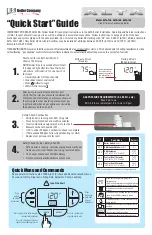
Part # 4523974 Rev 2 (05/06/14)
Page 15
INSTALLATION Continued
Ventilation and Air Supply
Proper ventilation is highly important for good operation.
The ideal method of ventilation for a Salamander Broiler is
the use of a properly designed canopy hood which should
extend six inches (6”, 152mm) beyond all sides of the
appliance and six (6) feet six (6) inches (1981mm)from the
fl oor.
A strong exhaust fan will create a vacuum in the room. For
an exhaust system to work properly, replacement air must
enter the room in which the vent is located. The amount
of air which is exhausted must equal the amount entering,
(make-up air).
All gas burners and pilots need suffi
cient air to operate and
large objects should not be placed in front or on top of the
broiler which would obstruct the air fl ow through the front of
the broiler.
The following notes are intended to give general guidance.
For detailed recommendations, refer to the applicable
code(s) in the country of destination.
NOTE 1: The room containing the appliance is required to
have a permanent air vent. The minimum eff ective area of
the vent is related to the maximum rated heat input of the
appliance and shall be 4.5 cm² per kW (2.04 X 10-4 in² per
BTU/H) in excess of 7 kW. (23,900 BTU/H).
NOTE 2: Air vents should be of such a size to compensate for
the eff ects of any extract fan in the premises.
FOR YOUR SAFETY never place any type of object on top of
the salamander broiler. The top of the broiler will exceed
1000° F (538° C). It could cause severe burns and/or fi re
and also will obstruct ventilatio
n.
Clearances
Clearance must be 6” (152mm) at the sides and rear from
combustible material. A clearance of 0.0” to noncombustible
construction at the sides & rear is acceptable, for the
Salamander.
This appliance is for use on non-combustible fl oors/counters
only.
OPERATION
Pilot Lighting Instructions
1. The in-line service shut-off valve should be in the “ON”
position.
2. With a lighted taper you can now light the pilots which
are located at the rear of the main burner.
3. The Pilot fl ame should be approximately 7/8” long for
proper ignition of the burners. The pilot adjustment
valve can be located by sliding the drip tray forward.
Adjustment valves are located on the manifold pipe
which runs horizontally across the back of the unit,
behind the drip tray. One valve is at the left rear and the
other at the right rear.
To adjust the pilot light, turn the brass screw counter-
clock-wise to increase the pilot fl ame, and clock-wise to
decrease the pilot fl ame.
NOTE: No more than 7/8” pilot fl ame length should be
required. Too high a setting will cause the fl ame to lift off or
will create excessive carbon deposits. Do not adjust the pilot
fl ame lower than 7/8” long because this can cause delayed
ignition at the burner. The delayed ignition could cause the
burner tiles to crack; in that case the burner would have to be
replaced.
Main Burner Operation
Turn main burner knob to the “MAX” position and
immediately check ignition.
CAUTION Should ignition fail after fi ve seconds, turn valve
off and wait fi ve minutes before trying again. Pilot gas is
not interrupted automatically. It is the responsibility of the
operator to check the ignition of burners immediately after
the burner valve has been turned on.
When ignition has been accomplished, a blue fl ame will
cover the surface of the ceramics for 10-15 seconds. The haze
will disappear and the burner rod will glow red. After the
burners have operated for several minutes turn the valve to
“MIN.” The burner rods will no longer glow red and the fl ame
travels back and forth on the face of the burner ceramics.
Burn off Period
Many parts used in the manufacturing of commercial
equipment have a thin, protective coating of machine oil.
This oil should be burned off before the equipment is used
for food preparation.
After all start-up and safety checks have been completed,
turn burner valve to the “MAX” position. Smoke (a bluish
haze) will be produced. This process can take several hours
and can be completed over a few days.
















































